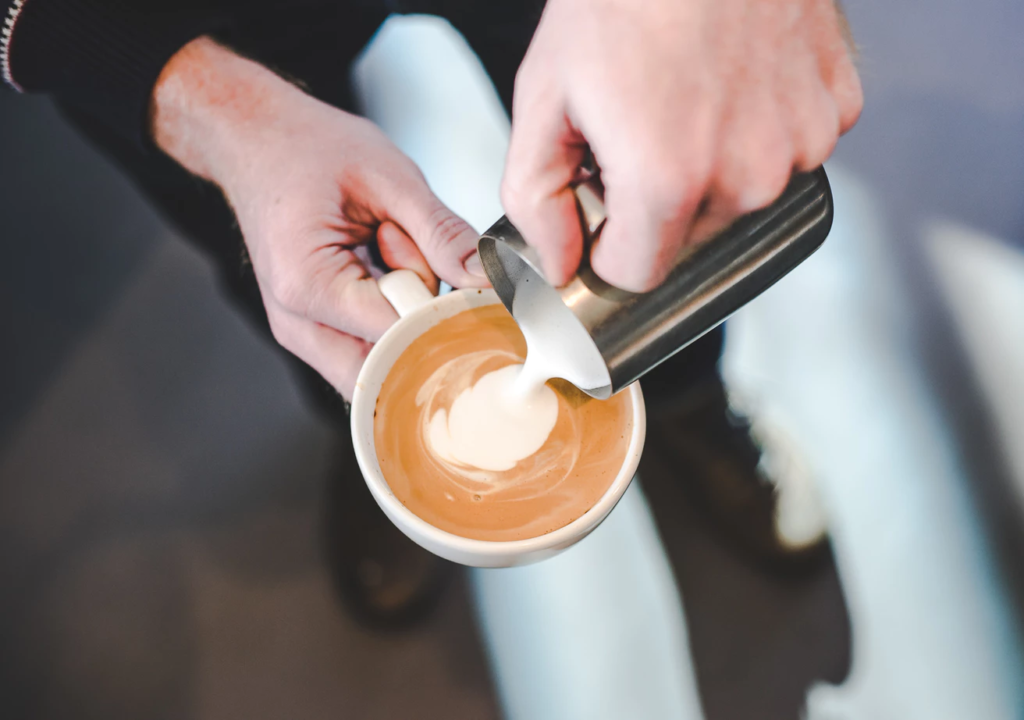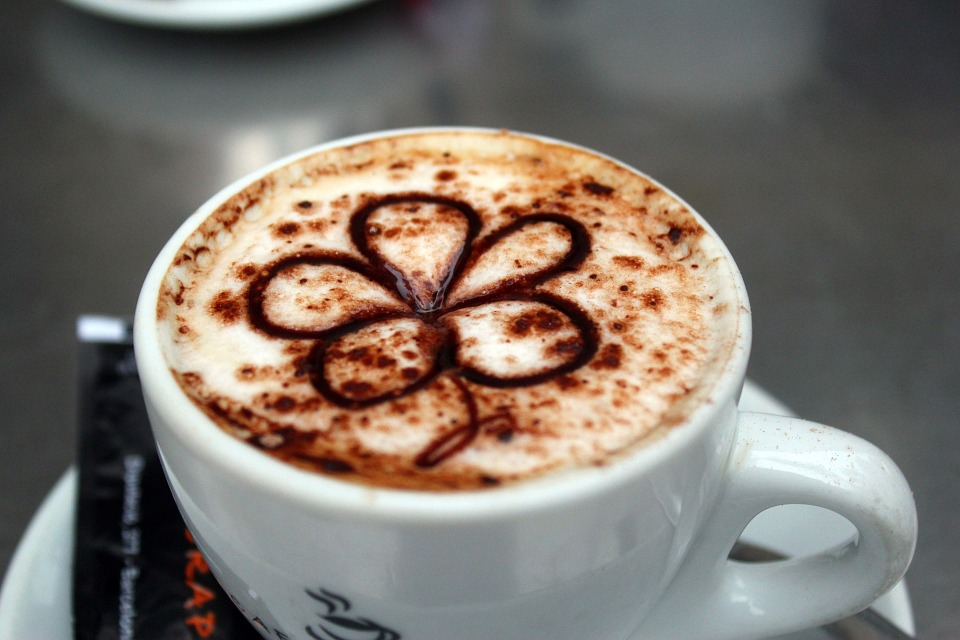BY: ANGELINA SCHIANO
Ah, winter. Fireplaces, scarves, and finally focusing on peppermint mochas instead of pumpkin spice lattes.
Say what you want about these sugary drinks; they’ve made Starbucks millions. The coffee beverage industry is extremely lucrative, with US coffee shop sales expected to increase to top $28 billion by 2021 [1]. With more and more players entering the market, including ready-to-drink alternatives, coffee beverage retailers are constantly on the lookout for ways to differentiate their products.
Unusual flavors, natural ingredients, and protein fortification are popular ways to increase the value and uniqueness of coffee beverages, but recently, some companies are turning to texture and visual appeal to lure in customers, shining a spotlight on foams and latte art.
What’s the big deal about foam and latte art?
Milk foam is an essential component of any latte or cappuccino. Latte art refers to patterns or designs created on the surface of the beverage when pouring that milk foam into espresso.
The practice has long been popular in small, artisan coffee shops, but has recently gained popularity to the point where latte art competitions are now held throughout the world. Baristas can enhance designs by spreading on chocolate syrup, sprinkling cocoa powder through stencils, or using a pointed tool to create a pattern in the foam after it has been poured.
The visual appeal of these lattes have people willing to pay 11% more for coffee beverages with latte art [2]. Consumers view these beverages as requiring more skill to produce, and therefore inherently higher quality.
Turns out, some major players are willing to bet that the foam on coffee beverages is going to be a big deal. In April earlier this year, Starbucks introduced its line of “cold foam” iced coffees, hoping to create a chilled offering as popular as those ubiquitous pumpkin spice lattes.
Just this month, Nestle put out press releases advertising its newest offering, ready-to-drink (RTD) coffee protein smoothies that form a layer of “barista-inspired” foam after shaking [3].
A large segment of latte-style beverage consumers is influenced by the location and experience surrounding coffee consumption and are more likely to purchase “artisan” or “coffeehouse” coffee beverages [4]. A layer of silky-smooth, creamy foam is an essential part of the experience of drinking an artisan latte or cappuccino, and these companies know that bringing that experience to cold brew or RTD coffees is a sure-fire way to win over consumers.
So how does this work exactly? What makes good latte foam? Does all milk foam make latte art?
Beverage Basics
Before we go too far into the wonderful world of milk foams, let’s get on the same page about the coffee this milk is added to.
You’ve most likely encountered latte art on a latte or cappuccino, which are both made from differing ratios of espresso, steamed milk, and milk foam. A classic cappuccino consists of ⅓ espresso, ⅓ milk, and ⅓ foam, while a latte consists of ⅔ milk, ⅙ espresso, and ⅙ foam [5].
The iced versions of these beverages are less straightforward. Although cappuccinos are occasionally prepared with iced or cold brew coffee and hot foam, this is a controversial – and often ridiculed – beverage choice [6]. Hot foam almost instantly liquefies in cold coffee, resulting in an unappetizing beverage with very little discernable foam.
The far more popular iced latte typically refers to a cold, sugary milk and coffee drink with no foam at all. Of course, Starbucks is changing this by bringing cold foam iced lattes to the market.
So why is an iced cappuccino ridiculous to coffee critics? Dumping warm foam into a cold beverage isn’t the best idea. It melts, liquifies, and results in an unappealing, unsatisfying beverage.
Cold foam doesn’t have these issues because the foam itself is as cold as the coffee. By how? It has to do with how baristas prepare foam for beverages such as lattes and cappuccinos, which in turn depends on the very basics of milk foams.
Foam Stability
Back to Food Science 101 for a minute: a foam is a colloidal system consisting of a gas dispersed in a liquid or solid. In the case of milk foam, we’re talking about a gas (air) dispersed in a liquid (milk). Although milk is itself an emulsion, so the story is a bit more complex.
Like all colloids, milk foams are not stable, and will eventually separate out.
Milk foams in coffee beverages become unstable in 3 ways:
- Coalescence – gas bubbles combine to form larger bubbles
- Disproportionation – transport of gas from smaller to larger air bubbles
- Drainage – draining of liquid from foam
The typical consumption time for a cappuccino-style beverage is 10-15 min, so a milk foam will need to be stable for at least that long in order to work in this system [7]. Proteins are the main stabilizing element in milk foams (they stabilize the system by forming a visco-elastic surface film), although polar lipids, free fatty acids, and phospholipids also contribute to stability [7].
Temperature, milk fat content, and method of foam preparation all impact milk foam stability.
Making Latte Foam
Milk foam is made in coffee shops in one of two ways: hot steam injection or cold agitation [7]. Hot steam injection is by far the most common. A specialized nozzle on an espresso machine releases steam at a controlled rate, allowing a barista to rapidly heat and froth milk by incorporating air bubbles.

A barista steams milk using an espresso machine, resulting in a steam injected milk foam.
The resulting foam is thick and silky with fine bubbles, perfect for pouring latte art.

Thick, fine-bubble milk foam produced by steam injection. Source: https://unsplash.com/photos/-Rwjvuz6pXA
Cold agitation is like whipping cream. The milk is whipped, blended, or otherwise agitated when cold.
The properties of each foam largely depend on the fat content of the milk used to make it, but a big difference between cold agitation and steam injected foams is the distribution of the air bubbles. Steam injected foams tend to be “airier” on top and thicker/more liquid towards the bottom of the container, while agitated forms are more uniform [8].
As with all food processes, the process specifics can have a huge impact on the quality of the final product. Small tweaks to the temperature, agitation rate, air flow, or other parameters can make the difference between silky-smooth foam and a bubbly mess. Individual retailers usually test their equipment and ingredients to find the ideal settings.
Fat Content and Temperature
In a coffee shop, you’re most likely to find whole (~3.5% fat), reduced fat (1-2% fat), or skim (<0.5% fat) milk. While milk foams are richer but generally less stable than skim milk foams, although this depends on the method used to prepare the foam and the characteristics of the milk itself (such as pasteurization and homogenization method) [7, 8].
This stability change is due to the crystalline structure of the milk fat, which depends on the temperature of the milk. Partially crystallized fat globules, such as those found at temperatures below 40 °C, are more likely to rupture during foam formation. Ruptured fat globules spread lipids out across the surface of air bubbles in the resulting foam, increasing the rate of coalescence [7].
Whole milk foam prepared at 20-30 °C will only be stable for a few minutes but are just as stable as skim milk when prepared above 50 °C [7]. Therefore, whole milk is not a proper vehicle for a stable cold foam, unless you include additives that might help stabilize the foam and prevent the fat from rupturing.
Cold agitation and steam injection skim milk foams are equally stable [8]. They can be stable for longer than 1 hr, during which time the air bubbles increase slightly in size and the proportion of liquid below the foam increases, but the height of the foam does not noticeably change [7]. This makes skim milk foams especially good for lattes and cappuccinos because while the overall volume of foam will decrease as the drink sits out, the appearance of the top of the drink won’t change significantly.
Non-Dairy Foams
The whipping and foaming properties of plant-based dairy alternatives have not been as extensively studied as those of dairy milk, and more research is needed on the suitability of plant proteins for latte foams. While there are some published studies, cover general foam capacity and stability of plant flours and isolates rather than the foaming properties of plant-based milk alternatives [9, 10, 11].
In general, dairy alternatives with adequate protein (such as almond or soy milk) will produce acceptable cold or hot latte foam, although the parameters of the foaming process may differ from those used for dairy milk.
According to Starbucks, their almond milk has been specially formulated with less sugar and increased foaming ability [12]. With plant-based alternatives gaining in popularity, it would be no surprise to see more of these signature milk blends on the market soon.
The Ideal Latte Art Foam
So what does all this mean for your latte – and your latte art? To start, cold foams prepared with whole milk are a bad idea for coffee beverages. They’re just not stable enough. Nobody wants latte foam that liquifies as they drink, so if you want the rich, creamy taste of whole milk foam, stick with steam injection.
Those mysterious Starbucks cold foams now start to make a lot more sense. The foams are prepared by blending skim milk in a high-powered blender which results in a smooth foam with small, uniform air bubbles. On an iced latte, the cold foam sits neatly on top of the coffee without mixing.

Cold foam on Starbucks beverages.
The same attributes that keep cold foam from mixing into beverages makes it unsuitable for latte art. Remember, cold agitated foams have a uniform texture throughout, while steam injected foams get denser (closer to milk consistency) towards the bottom of the container.
Pouring latte art requires free-flowing milk foam. Anything too stiff will just plop into the cup. While latte art involving cocoa stencils or spooning foam into the cup will work with cold foam, anything that requires pouring will be impossible without the density gradient of steam injected foam.
That’s not to say that steam injection always produces perfect latte art foam. Changing the parameters can result in a milk foam with oversized air bubbles, resulting in latte art challenges and a “spongy” appearance.

Steamed milk with air bubbles too large for latte art. Source: https://en.wikipedia.org/wiki/Microfoam#/media/File:Steamed_milk.jpg
The Future of Foams
Coffee beverage retailers are constantly trying to bring novel experiences to the market, and new takes on latte foams and latte art are an area for innovation. Recent product releases took advantage of basic foam properties to introduce new combinations of texture and temperature, and it’s likely future products will future products will incorporate new ingredients, foaming methods, and visual elements.
While it’s hard to predict what products will gain popularity, we can probably expect to see an increase in cold coffee beverages served with foam. Custom blends of plant-based milk alternatives, specifically formulated for foaming ability, could also become more common. Ready-to-drink products, which are typically sold in plastic bottles with few elements of “artisan” coffees, may try to incorporate foams or latte art in order to reach a wider audience.
Regardless of whether you prefer lattes or cappuccinos or hot or cold foam, it’s an interesting time to keep an eye on the coffee market.
Want to learn more? Follow us on Instagram and Facebook for quick updates on seminars, events, and food science!

Latte art with a chocolate syrup flower. Source: https://pixabay.com/en/coffee-cappuccino-espresso-cafe-164058/
References
[1] http://www.mintel.com/press-centre/food-and-drink/us-coffee-house-sales-expected-to-reach-28-7-billion-by-2021
[2] Van Doorn, G., Colonna‐Dashwood, M., Hudd‐Baillie, R., & Spence, C. (2015). Latté Art Influences both the Expected and Rated Value of Milk‐Based Coffee Drinks. Journal of sensory studies, 30(4), 305-315.
[4] Jervis, S. M., Lopetcharat, K., & Drake, M. A. (2012). Application of ethnography and conjoint analysis to determine key consumer attributes for latte‐style coffee beverages. Journal of sensory studies, 27(1), 48-58.
[5] http://mentalfloss.com/article/563136/cappuccino-vs-latte-what-is-the-difference
[6] https://drinks.seriouseats.com/2012/07/stop-ordering-iced-cappuccinos.html
[7] Huppertz, T. (2010). Foaming properties of milk: A review of the influence of composition and processing. International Journal of Dairy Technology, 63(4), 477-488.
[8] Jaclyn, G. O. H. (2009). Comparison of mechanical agitation, steam injection and air bubbling for foaming milk of different types. Milchwissenschaft, 64, 2.
[9] Yasumatsu, K., Sawada, K., Moritaka, S., Misaki, M., Toda, J., Wada, T., & Ishii, K. (1972). Whipping and emulsifying properties of soybean products. Agricultural and Biological Chemistry, 36(5), 719-727.
[10] Ogunwolu, S. O., Henshaw, F. O., Mock, H. P., Santros, A., & Awonorin, S. O. (2009). Functional properties of protein concentrates and isolates produced from cashew (Anacardium occidentale L.) nut. Food Chemistry, 115(3), 852-858.
[11] Vani, B., & Zayas, J. F. (1995). Foaming properties of selected plant and animal proteins. Journal of food science, 60(5), 1025-1028.
[12] https://news.starbucks.com/news/almondmilk-coming-to-starbucks-stores






I love this article! Great breakdown of the science and the art behind foarm art and the consequences of the different methods. This was informative and enjoyable to read!
I thought the same thing! Awesome! So much science for a cultural obsession makes it that much cooler. 🙂